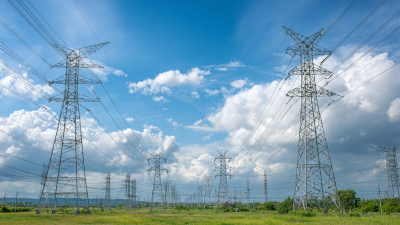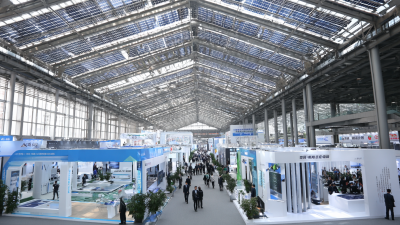Harnessing Energy Solutions for a Sustainable Future and Exploring Innovative Technologies
In the quest for a sustainable future, the significance of energy solutions cannot be overstated. According to the International Energy Agency (IEA), energy demand is expected to rise by 30% by 2040, driven by population growth and urbanization. This necessitates urgent innovations in energy technologies that can efficiently meet this growing demand while mitigating carbon emissions. The Global Renewable Energy Report indicates that renewable energy sources—such as solar, wind, and hydro—could supply over 80% of the world's electricity by 2050 if harnessed effectively. Furthermore, advancements in smart grid technology and energy storage are poised to revolutionize how energy solutions are integrated into existing infrastructures. By focusing on these innovative technologies, we can pave the way towards an economically viable and environmentally responsible energy landscape that supports future generations.

Exploring Renewable Energy Sources: Current Trends and Future Projections
In 2024, the global green data center market is projected to reach $81.75 billion, with expectations to grow from $95.28 billion in 2025 to $307.52 billion by 2032, reflecting a remarkable compound annual growth rate of 18.0% during this period. This growth signifies a trend towards sustainable energy solutions as more companies seek to implement environmentally-friendly practices in their operations. Furthermore, China's renewable energy capacity has surpassed coal-fired power, establishing itself as the country's first major energy source. The significant enhancement in large-scale optimization capabilities of renewable resources is indicative of the ongoing rapid expansion within this sector, particularly during the 14th Five-Year Plan period.
Renewable energy markets are also seeing substantial growth globally, with the renewable energy market size valued at approximately $102.94 billion in 2024. Projections suggest an increase to $157.42 billion by 2032, showcasing a steady growth rate of 5.55%. The wind energy sector, in particular, demonstrates a positive trajectory, with China's cumulative wind power installations reaching 44.135 million kilowatts by the end of 2023 and expected to rise significantly in the following years. This ongoing shift towards harnessing renewable energy resources aligns with both current trends and future projections, underscoring the crucial role of innovative technologies in creating a sustainable future.
Exploring Renewable Energy Sources: Current Trends and Future Projections
Integrating Smart Grids: Enhancing Efficiency and Reliability in Energy Distribution
The integration of smart grids represents a transformative step towards enhancing efficiency and reliability in energy distribution. By leveraging advanced technologies such as IoT devices, artificial intelligence, and real-time data analytics, smart grids facilitate a more dynamic interaction between energy producers and consumers. This interconnectedness allows for the optimization of energy flow, enabling utilities to better manage electricity generation and consumption patterns while reducing waste and minimizing outages.

Moreover, smart grids empower consumers through innovative tools that provide insights into their energy usage. Features such as smart meters and mobile applications create opportunities for individuals and businesses to monitor their consumption more closely and adjust their habits accordingly. This not only fosters a culture of energy conservation but also supports the integration of renewable energy sources. As production from solar panels and wind turbines becomes more prominent, smart grids can effectively manage the variability of these assets, ensuring a stable and reliable energy supply while promoting sustainability.
Evaluating Energy Storage Solutions: Key Technologies and Market Developments
The urgency of developing energy storage solutions in response to climate change and global targets, such as the Paris Agreement, cannot be overstated. With the increasing reliance on renewable energy sources like wind and solar, energy storage technologies have become essential for managing the intermittent nature of these resources. The economic and environmental benefits of various energy storage methods are being assessed, revealing their potential to enhance hybrid energy systems and reduce the reliance on fossil fuels. As investors begin to recognize the true revenue potential of energy storage technologies, there is a growing need for innovative evaluation approaches that align with the realities of the market.
In South Asia, studies show a promising outlook for energy storage development, particularly as countries like India set ambitious targets for renewable energy capacity. The energy storage system market is projected to grow significantly, potentially reaching USD 86.76 billion by 2032, driven by the renewable energy boom. This growth highlights the critical role that policy evolution, public attitudes, and investments in energy storage will play in building a sustainable energy future. As the demand for efficient energy solutions continues to rise, the integration of innovative technologies in energy storage will pave the way for more resilient and sustainable energy systems globally.
Harnessing Energy Solutions for a Sustainable Future and Exploring Innovative Technologies
| Energy Storage Technology | Energy Density (Wh/kg) | Cycle Life (Cycles) | Cost ($/kWh) | Market Share (%) |
|---|---|---|---|---|
| Lithium-ion Batteries | 150-250 | 500-1500 | 150-400 | 40 |
| Lead-Acid Batteries | 30-50 | 300-500 | 100-200 | 15 |
| Flow Batteries | 20-40 | 2000+ | 350-700 | 10 |
| Sodium-Sulfur Batteries | 100-150 | 2000+ | 200-400 | 5 |
| Supercapacitors | 5-10 | 100000+ | 200-1000 | 8 |
Innovative Technologies in Solar and Wind Energy: Breakthroughs Driving Sustainability
Innovative technologies in solar and wind energy are pivotal in driving sustainability and addressing the global energy crisis. Recent breakthroughs have enhanced the efficiency of solar panels through advancements in photovoltaic materials, such as perovskite cells, which offer higher energy conversion rates at a lower production cost. These developments allow for more versatile applications, from residential rooftops to large-scale solar farms, significantly increasing the potential for clean energy generation.
In the realm of wind energy, technological improvements have led to the design of larger, more efficient turbines capable of harnessing wind power even in low-wind areas. Innovations like vertical-axis wind turbines and floating offshore wind platforms open new avenues for capturing wind energy where it was once unfeasible. Coupled with smart grid systems that optimize energy distribution and storage, these advancements not only enhance the reliability of renewable energy sources but also make a substantial contribution to the global efforts to combat climate change, paving the way for a more sustainable future.

Assessing Government Policies: Impact on Energy Innovation and Sustainable Practices
Government policies play a pivotal role in shaping energy innovation and promoting sustainable practices across various sectors. According to a report by the International Renewable Energy Agency (IRENA), nations that implement supportive policies can increase renewable energy investments by up to 70%. For instance, the introduction of tax incentives and subsidies for solar and wind projects has significantly accelerated investment in these sectors. Countries like Germany and Denmark have demonstrated that ambitious policy frameworks can lead to remarkable advancements in renewable energy capacity, contributing to their goal of achieving carbon neutrality by 2050.
Tips: To support sustainable energy practices, consider advocating for local and national policies that favor renewable energy projects. Engage in community initiatives that promote energy efficiency and sustainability. Your involvement can significantly influence decision-makers and encourage further investment in innovative energy technologies.
Furthermore, the Global Wind Energy Council (GWEC) reported that government support mechanisms, such as feed-in tariffs and renewable portfolio standards, are critical for stimulating market growth. Innovative technologies like smart grids and energy storage systems benefit immensely from these policy frameworks, allowing for more efficient energy distribution and consumption. By prioritizing sustainability in their policies, governments can not only enhance energy security but also create economic opportunities through job creation in the green technology sector.
Tips: Stay informed about local energy policies and participate in public forums. Your awareness and advocacy can amplify efforts towards a sustainable energy transformation in your community.
Related Posts
-

How to Optimize Your Business's Energy Solutions for a Greener Tomorrow: Key Metrics and Strategies
-

What is the Future of Solar Energy in Sustainable Development
-

Empowering Solar Innovations at the 138th China Import and Export Fair 2025
-

Empowering Tomorrow: How Solar Power Solutions are Revolutionizing Energy Futures
-

How to Optimize Your Solar System Electricity Setup: A Step-by-Step Guide for Maximum Efficiency
-

How to Harness the Power of Future Solar for Sustainable Energy Solutions
